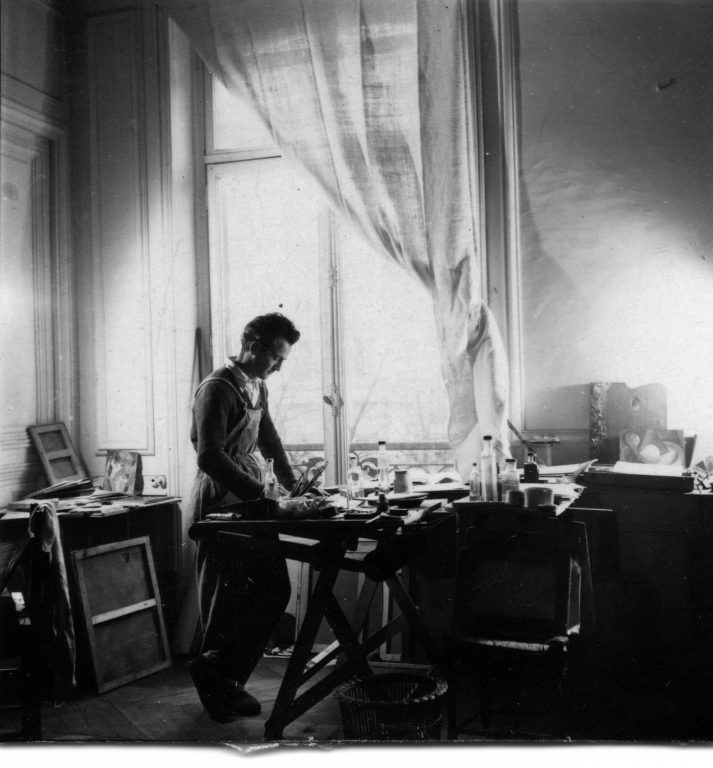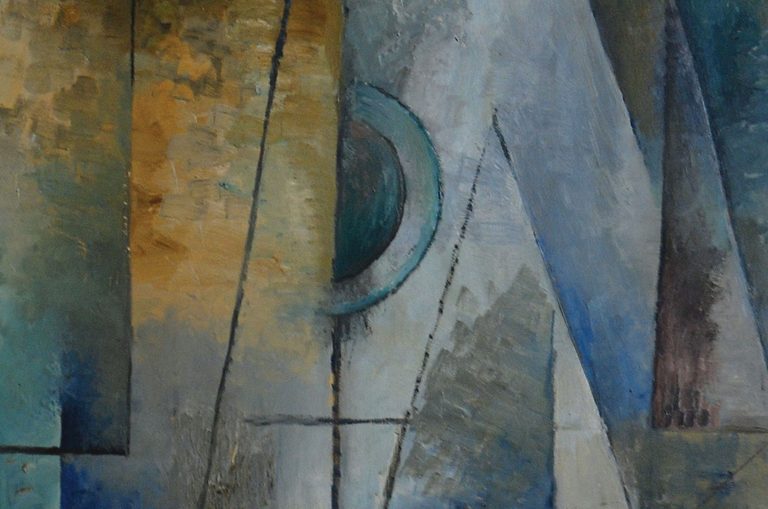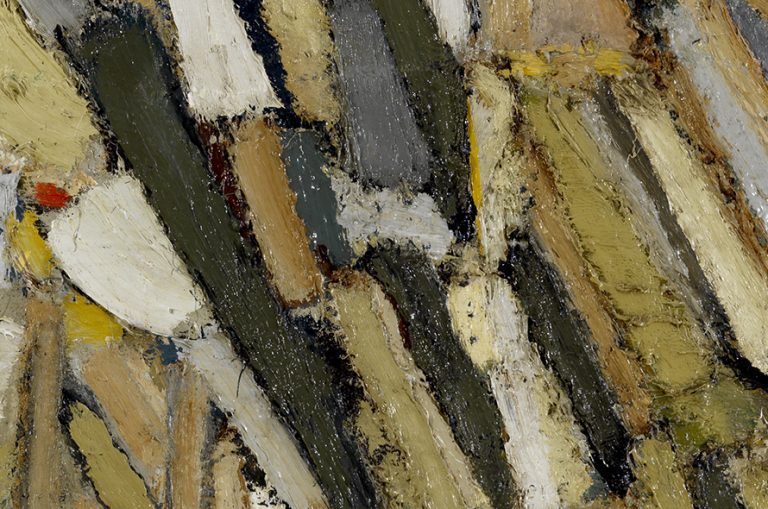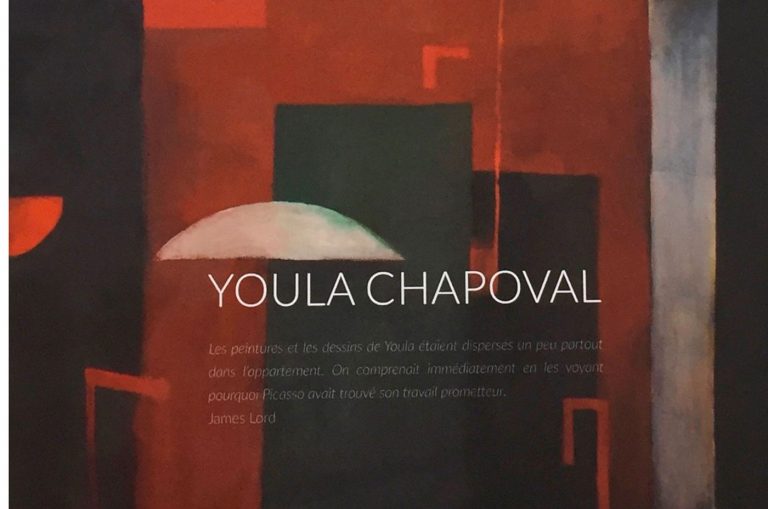Born in 1919 in Kiev, Youla Chapoval was the third child of a bourgeois Jewish family of jewelers. After a happy childhood, Chapoval and his family were forced, as a result of the Russian Revolution, to leave Ukraine. They moved to Paris in 1924, as did many Russians who imagined France to be an ideal country of freedom and good living.
In November 1938 Chapoval met Pablo Picasso, with whom he would soon develop a close friendship. It was also during this period that he met Jean Cocteau, who would influence the development of his interest in poetry.
By 1942 he had moved to the rue du Faubourg St. Jacques, where he made the acquaintance of Jean Degottex and Apel Fenosa. Both vigorously encouraged him to draw and paint. Chapoval would choose to abandon medicine and literature in order to devote himself exclusively to painting, and would assiduously attend the Académie de la Grande Chaumière.
Meanwhile the political climate in Paris deteriorated. Following the Vel d’Hiv Roundup in 1942, Chapoval was forced to take refuge in the “free zone” in Marseille, where he studied at the École des Beaux-Arts. In Marseille, he met the art critic Roger van Gindertaël, who would play a decisive role in his career. His early works, executed between 1942 and 1945, were characterized by a figurative and realist style, close to fauvism, based around portraiture, landscape and still life.
In 1944, upon his return to Paris, he learned of the death of his mother and his older sister, who had been deported to Auschwitz.
1946 would see an important new stage in his development. He met Henri Benezit, an art dealer who acquired some twenty of his canvases, and introduced him to the great collector Roger Dutilleul. His artistic expression veered towards new forms of cubism, with more structured compositions determined by geometric schema in which shadow and light play with the harmony of colors. In his work from this period one can discern the influence of Juan Gris, Albert Gleizes and André Lhote.
After Chapoval took 2nd prize in the Prix de la jeune peinture in May 1947, the Jeanne Bucher Gallery organized his first solo exhibition in November of the same year. It was one of the very first hangings done by Jean-François Jaeger, great-nephew of the gallery’s founder. Roger van Gindertaël wrote an introductory text on the invitation card, thus taking up the tradition of dialog between artists and poets. He placed Chapoval between figuration and abstraction, and concluded by writing “Chapoval, without a vain metaphysics, reserves for himself the part of poetic–or mystical– feeling, which remains the ultimate raison d’etre of painting”. A cohort of amateurs gathered at the Boulevard du Montparnasse, among them Jacqueline Auriol, daughter-in-law of the recently elected President of the Republic, and Georges Pompidou, who acquired his first abstract work, “Bière moussante” presented in the exhibition. The French government acquired two works, “Nature morte au citron” and “Verre et cristal”.
1948 would see the birth of his first abstract compositions, punctuated by long diagonals. His use of shaded monochromes, and the appearance of warm grey, blue, and/or green tonalities, confer luminous subtleties onto these works.
1949, although clouded by the death of his father and his divorce, was the year when Youla Chapoval would finally know great success. Recognition would come in the form of a second solo exhibition at the Gallery, inclusion in the Salon de Mai and the Salon des Réalités nouvelles, and the winning of the Kandinksy prize. In canvases from this year, circular and geometric shapes drown in warm colors.
1950 saw a new evolution of the artist through contact with Charles Estienne and Hans Hartung. The precision of forms gave way to a freer movement of the brush. Seeking to return to a narrative tradition of painting, the artist explained himself: “My non-figurative canvases became too sure of themselves, their execution tended towards the mechanical; the emotion became exhausted and lassitude crept in as the act of painting became more methodical. I began a totally new course of studies directly after nature in parallel with these compositions of the imagination”. (Journal, November 8, 1950).
Constructed forms disappeared little by little, giving way to a more lyrical movement where “baroque forms are searching for their proper disposition, more organic than architectural. What matters… is the vibration of the material where red glows of fire sometimes light up, which nothing could extinguish”. (CR Chapoval p. 22, preface by Christian Briend)
On December 19, 1951, his sister and his friends grew worried by his silence and came to his house. Chapoval was found there dead, in his bed, a book in hand. He had likely died in the night between December 16 and 17.
His works figure in the illustrious private collections of Jean Masurel, Fernand Graindorge and Gildas Fardel, as well as in the great French and international Museums. In France they can be found at the Centre Pompidou, at the Musée d’Art Moderne de la Ville de Paris, at the LAM, at the Musée des Beaux-Arts in Nantes, at the Musée Fabre…, and outside of France at the Musée des Beaux-Arts in Liege, the Museum of Modern Art in Tel-Aviv, and the Cleveland Museum of Art, among others.
More than 700 canvases, numerous gouaches, drawings, charcoals, and inks resulted from the “meteoric” trajectory of the artist’s 9 creative years. It was an intense rhythm of creation, imprinted with an urgency, in unison with the forces at work in the universe as he himself said: I feel that my work is not so solitary as it appears, that in fact it tends toward rejoining a universal rhythm whose laws govern the growth of plants and the course of the stars.
downloads
Jeanne Bucher Jaeger — St Germain Space
Photograph by Grégory Copitet
Jeanne Bucher Jaeger — St Germain Space
Photograph by Grégory Copitet
Jeanne Bucher Jaeger — St Germain Space
Photograph by Grégory Copitet
Jeanne Bucher Jaeger — St Germain Space
Photograph by Grégory Copitet
Jeanne Bucher Jaeger — St Germain Space
Photograph by Grégory Copitet
Jeanne Bucher Jaeger — St Germain Space
Photograph by Grégory Copitet
Jeanne Bucher Jaeger — St Germain Space
Photograph by Grégory Copitet
Jeanne Bucher Jaeger — St Germain Space
Photograph by Grégory Copitet








